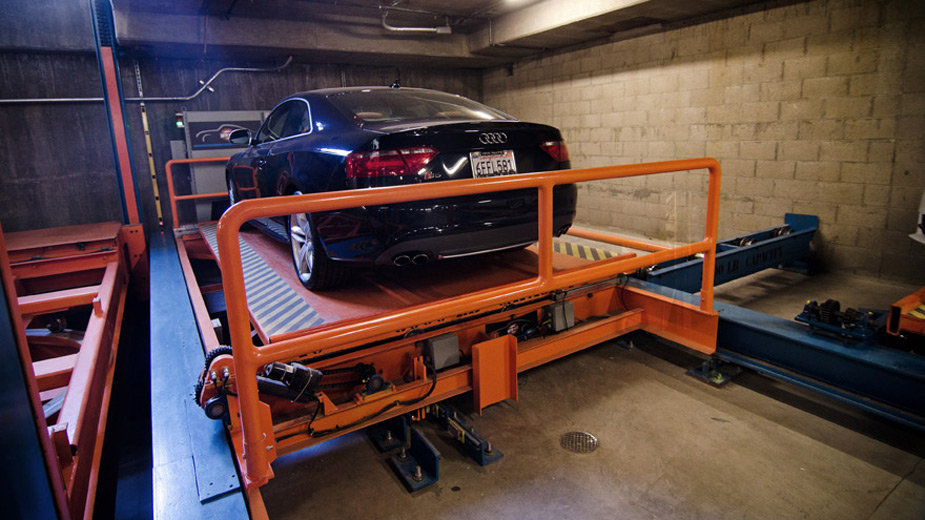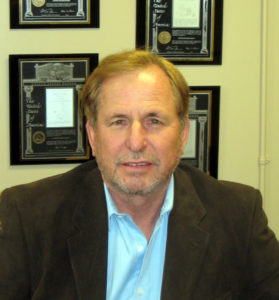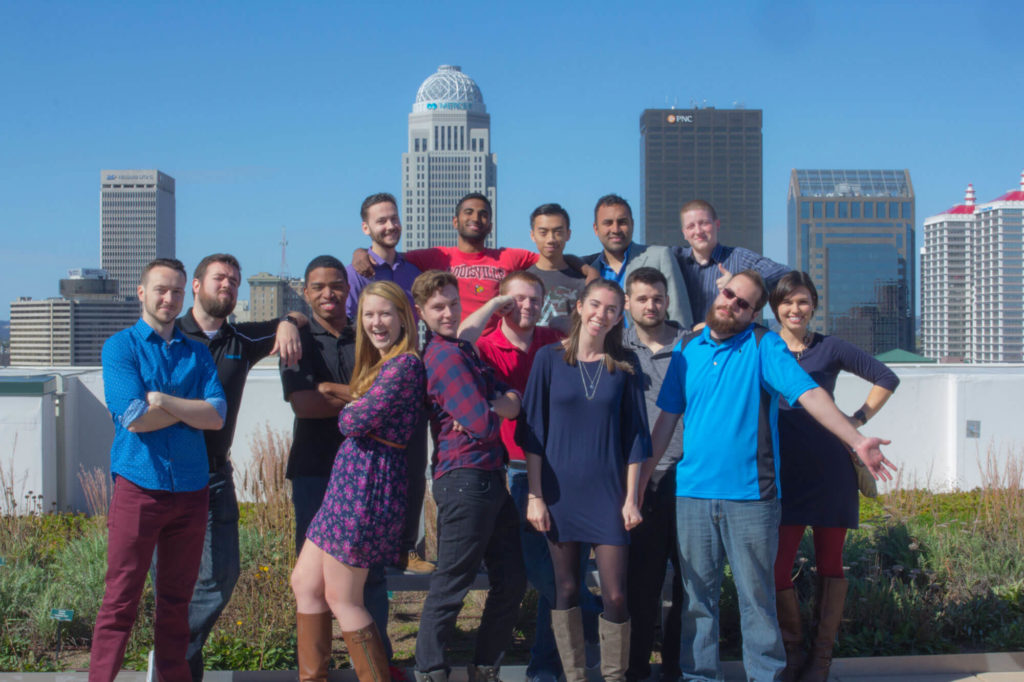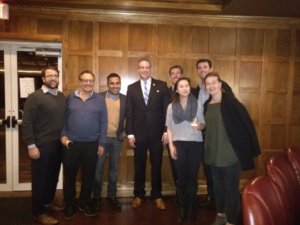How do you go about the tough, on the ground work of rebuilding jobs and opportunity in a hard-hit part of the country? Where will the new investment and fertile business partnerships come from?
Those were the questions raised last week when a group of 14 entrepreneurs and investors from Silicon Valley flew to Youngstown, Ohio to understand more about the economy in the Mahoning Valley. This is an area of the country that feels cut off from economic opportunity and was attracted to the Trump “America First” and his “bring jobs back to America” messaging.
We were motivated by understanding what we–one part of our nation–might do to help the economic and urban development of another. The effort was born of a unique friendship formed several years ago between San Francisco venture capitalist and multi-time entrepreneur Patrick McKenna with Rep. Tim Ryan (D) who represents Youngstown and Ohio’s 13th congressional district.
Youngstown, Ohio: A town with a heritage of steel manufacturing now struggling to rebuild
Located on the Ohio river with proximity to rail transportation, Youngstown (population 66K) it is part of a region with a long history of steel and heavy manufacturing that includes the city of Warren (population 42K). In the late 1970’s and early 1980’s the region lost 50,000 jobs as the steel business closed down. It has been working to reestablish is industrial core ever since.
To help the region rebuild jobs will not be easy. One encouraging source of revitalization: the outsized contributions of native sons (and–we hope–daughters) who have built businesses elsewhere.
Christopher Alan and AutoParkit
Christopher Alan created AutoParkit in Los Angeles to solve a very real problem he was having as a developer of residential real estate. Parking takes up a lot of space … space that could otherwise be devoted to apartments or condos. The AutoParkit system enables developers to park 2x the cars in the same space versus traditional parking structures.

This kind of stacked/automated parking system has become a big business and AutoParkit is one of the leaders in the sector.
When it came time to expand, Alan chose to move his growing manufacturing plant out of Los Angeles, California and back to his hometown of Warren, Ohio, located about 25 miles to the NW of Youngstown.
Alan is buying the old Delphi Packard electric plant in Warren, which is also the facility his father worked in years ago. Eventually, Allen hopes to employee 1,000 people in Warren — moving steel, designing parking systems, and assembling some of the largest urban machines made today. A single parking structure contract can run $20-30M.
The town’s economics, manufacturing heritage, and commitment to upskilling its workforce, made it practical for AutoParkit to set up its manufacturing plant there.
The median price per square foot for industrial space in Los Angeles (CA) is $261 and is trending in only one direction: up. Meanwhile, the equivalent price per square foot for Warren (OH) ranges from $2-$11. Not only is real estate less expensive but so too are average salaries for skilled workers. An operations manager in Los Angeles earns $72.6K versus $60.K in Warren—a difference of 17 percentage points. (Source: Payscale, 2017).
Alan also noticed another thing that’s inescapable about Warren, Ohio: it has a beautiful historic downtown.
Alan realized that this downtown had possibility, but that it was under utilized. He notes that there is a generative effect that happens when you invest in residential real estate. Residential real estate in a city’s downtown creates foot traffic and demand for specialty retail as well as restaurants and cafes. To capitalize on this generative effect, Allen is doubling down on his investment in Warren, snapping up buildings downtown that are ripe for residential redevelopment, and giving bonuses to his employees who choose to make downtown Warren their home.
When we wrote the book Maker City one of the questions we asked was whether the “downtown effect” could be replicated in smaller towns.
Downtowns are dense; density drives innovation and creativity, which attracts young people and new businesses creation. Warren, Ohio is an example of how this can come together, with a visionary investor helping to stoke the system. (When we asked Allen about this he reminded us that he was a developer from Southern California … where creating more vibrant downtowns has been a concern for years, to counter the effects of 20th-century sprawl.)
Jack Scott and Applied Systems and Technology Transfer
 After a 25 year career, Jack Scott–a native son of Youngstown, Ohio–recently retired as President and Chief Operating Officer of Parsons, one of the world’s largest engineering and construction companies based in Pasadena, California. Today, he heads up an organization known as Applied Systems and Technology Transfer, based in Youngstown to take advantage of the town’s heritage in advanced manufacturing.
After a 25 year career, Jack Scott–a native son of Youngstown, Ohio–recently retired as President and Chief Operating Officer of Parsons, one of the world’s largest engineering and construction companies based in Pasadena, California. Today, he heads up an organization known as Applied Systems and Technology Transfer, based in Youngstown to take advantage of the town’s heritage in advanced manufacturing.
The company trains students on the modern-tools of production including CAD/CAM and how to make prototypes using advanced 3D printers. Jack wants students to have the actual experience of building a 3D printer from scratch, as well as having access to a fleet of advanced 3D printers via the cloud. The 3D printers arrive as kits and are assembled by the students. Training started out targeting high school students but demand quickly spread into the middle and elementary schools. Once the high-school students have the skills they can segue into production (i.e. paid) work, becoming contractors to Applied Systems and Technology Transfer. Much of the training is delivered over the web (webinar, video) to make up for the fact that a small town like Youngtown does not have teachers with the necessary expertise. The most advanced printers are available as a cloud-based service; as a result, schools can invest less capital when building out a Makerspace to provide students with ongoing access to the modern tools of production.
This same system (basic 3D printers assembled locally; state-of-the-art equipment available in the cloud) also works for the military. Jack and his team deliver 3D printers kits to marine bases – to be assembled on site. Again, training is provided remotely … through a combination of webinars and video instruction.
Retraining: Not a Four-Letter Word
During the last election cycle a frequent refrain from de-industrialized parts of the country was, “retraining is a four letter word!” There have been many government retraining programs, but the linkage between required skills and job placement is often tenuous. Hence this often sounds like a broken promise.
One of the best models we saw for addressing this was presented by Ankur Gopal, founder and CEO of Kentucky-based Interapt, a firm that specializes in the development of mobile applications and wearable technology. For the past seven years and counting, Interapt has proven that great technology can be built outside of Silicon Valley.
 Gopal has proven that he can take people with no coding or technology experience and turn them into productive workers for his company. When he opened shop in eastern Kentucky (Appalachia) he established a training program that paid workers to get trained. Those who complete the program are guaranteed a job. Of the 50 who participated in the training, 35 completed the program, which was more than was expected. Gopal’s program is similar to career training in Chicago where community technical colleges cluster around seven industries which then absorb graduates.
Gopal has proven that he can take people with no coding or technology experience and turn them into productive workers for his company. When he opened shop in eastern Kentucky (Appalachia) he established a training program that paid workers to get trained. Those who complete the program are guaranteed a job. Of the 50 who participated in the training, 35 completed the program, which was more than was expected. Gopal’s program is similar to career training in Chicago where community technical colleges cluster around seven industries which then absorb graduates.
The IBM P-Tech (high school plus two years of community college) program is similar in providing training and a path to work. All of these come under the heading of middle skill jobs (IBM uses the term “New Collar Job” ) to refer to well-paying jobs that don’t require a four-year degree but which require considerable skill, skills that can be taught in a rapid, targeted fashion.
Net Takeaways
1// Native sons and daughters matter
Native sons (and daughters) who have built businesses elsewhere and return home can be powerful economic development stimuli. They bring skills, access to partnerships to drive additional sources of demand, capital, expertise, a knowledge of a town’s strengths, weaknesses, and work capabilities, as well as a sense for how to best utilize a town’s resources.
One reason that returning residents make such an outside contribution is that when a city like Youngstown loses industry it doesn’t just lose jobs. It often loses its most creative entrepreneurial people who go elsewhere looking for opportunity. The very people who will most reliably take risks, find new capital, start new businesses, and access new markets also leave to seek fortune elsewhere. It can be corrosive: The more business leaders leave, the more leaderless the town is. It’s as if you have a very capable town with skills but not enough risk takers, investors, and entrepreneurs figuring out what do and how to reach markets. Ergo, efforts to bring innovative talent back becomes paramount.
Recognizing this, Stanford University operates a fellowship that will forgive the $160K cost of an MBA to students who commit to two years in an economically recovering part of the country’s midsection, including Ohio.
2// Think about solutions regionally
There is great value in connecting strongly into the surrounding geographic network of capital, companies, and talent. It takes far less energy to link together cities that are an hours drive from Youngstown to help versus trying to import that talent from one of the coasts.
Youngstown, Ohio is part of a county that includes Warren, Ohio. Together what the two towns are doing makes for the beginning of a strong regional play, one that today encompasses Eastern Ohio but could also grow to serve as a greater region including Pittsburgh, Pennsylvania. Pittsburgh has successfully made the transition from steel to software and now from software to robotics and AI. It has enormous technical and entrepreneurial expertise. Pittsburgh has been down the path that Youngstown is on; it’s a natural nearby mentor and source of talent and capital.
Elsewhere, we’ve written about the fact that skilled workers need training in not just the modern tools of production but also in what some call the “understandings” of how to set up and run a business. For this, a business incubator can really help. Manufacturers and skilled workers sit next to more business-focused entrepreneurs and the two groups can learn from each other. Youngstown has a nationally recognized business incubator focused on the development of software and additive manufacturing companies throughout the Mahoning Valley. A number of us observed that a local incubator like the one in Youngstown would be stronger as part of a greater regional story with access to regional capital, talent, and mentoring.
When thinking about solutions regionally look for a major research university. Youngstown State University has a close relationship with America Makes, a national additive manufacturing research facility located on its campus. America Makes helps to develop new industrial processes for 3D printing.
3// Look for leadership in likely and unlikely places
One can’t speak about the Youngstown opportunity without speaking leadership. Our host was congressman Tim Ryan, a democrat who obsessed with economic development in Ohio.
Nationally, Tim is perhaps best known for challenging Nancy Pelosi for House Minority leader in 2017, largely on a platform of focusing on blue-collar communities in Ohio that voted for Trump because they didn’t hear a jobs message from the democrats (Ryan on the other had, won by 67%). We got to know Tim as one of the leader of the congressional Maker Caucus who helped bring the Maker Fair to Capitol Hill.
On this trip, Tim helped stitch together entrepreneurs from Silicon Valley with local elected official, incubators, the university, and economic development officials. He understands the need to build connections between the Mahoning Valley and other economic centers to drive growth. Tim’s tenure also frames how you get economic development done.
Tim’s thought hard about running for governor of Ohio in 2018. Do you bring about change by influencing national policy, or do you take on executive line authority in your region? As governor you have line authority over state economic development and community college resources, you can work with mayors and universities to create regional economic clusters, and you can call up the Pennsylvania governor and include Pittsburgh in your cluster.
Tim ultimately decided this week not to run for governor; he believes there is much that needs to be done on the national stage to drive the American manufacturing renaissance. Still, Tim strikes us as the practical line-oriented leader on a mission to build a thriving economy. That’s exactly the kind of person who would make a great governor at a time of rapid economic change. Felix Frankfurter famously said that our states are laboratories of democracy (popularized by U.S. Supreme Court Justice Louis Brandeis in New State Ice Co. v. Liebmann). He meant that in a diverse place like the U.S., the best ideas would bubble up from the many experiments and ideas at work in our states. In that sense, the U.S. is fortunate to have restless, curious leaders like Tim Ryan obsessed with regional innovation.
 Postscript
Postscript
Our participation in the Youngstown, Ohio was organized by Patrick McKenna, serial entrepreneur and venture capitalist. Patrick is on a mission to develop companies and investments far away from Silicon Valley on the theory that a strong nation has a strong economy in many zip codes, not just a few clustering on the East and West coasts (most venture capital investment is in New York, Boston and San Francisco).
Relevant Links
- Valley Resources Impress Technology Delegation – Business Journal, Feb 2017
- The City that Embraced Its Decline – City Lab, July 2016
- How Rust Belt City Youngstown Plans to Overcome Decades of Decline – PBS, April 2016
- Chicago High School/College Hybrids to Offer College, Job Training – U.S. News & World Report, March 2012
